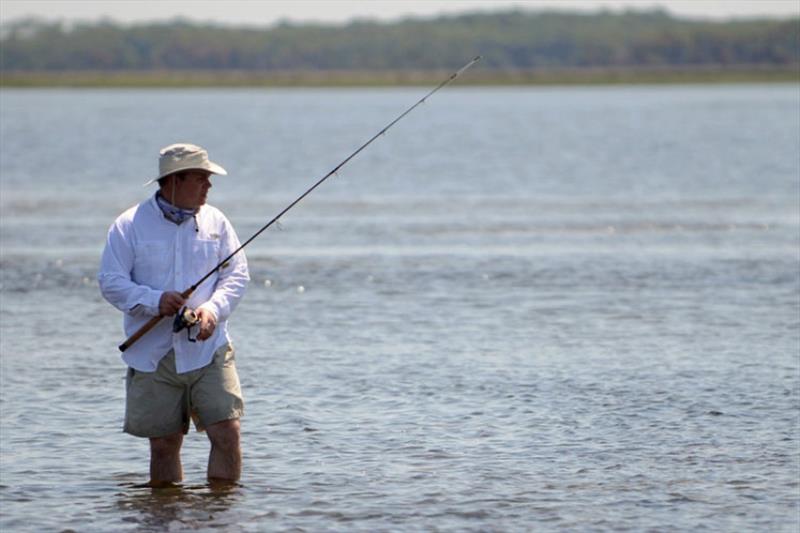
Exploring electronic reporting for recreational fishing data
by NOAA Fisheries 1 Aug 2019 14:22 UTC

Exploring electronic reporting for recreational fishing data © Tim Donovan / Florida FWC
This month, NOAA Fisheries submitted a report to Congress (PDF, 19 pages) describing the Marine Recreational Information Program's (MRIP) efforts to explore the suitability of electronic reporting as a method of collecting data from saltwater anglers.
Electronic reporting is a method of data collection that can include smartphones, tablets, and other technologies used to record, send, and store data. In some cases, electronic reporting allows samplers to use tablets instead of paper and pencil to record and submit data collected in the field. In others, electronic reporting allows anglers to record and submit data through a website or mobile device.
Electronic reporting has the potential to reduce data collection costs and improve the quality of reported information, and several states—including Alabama and Mississippi—have adopted mandatory or voluntary angler reporting apps. But the challenges associated with using these technologies to collect data from private anglers—especially when anglers are asked to voluntarily report their data through a website or mobile app—have the potential to bias resulting estimates.
Opt-in angler reporting programs have experienced low recruitment and retention rates, as well as a tendency for more avid angler to participate. To correct for these and other potential biases, independently conducted shoreside sampling must be used to confirm or correct missing or misfiled angler electronic reports. Shoreside validation is crucial, but adds cost and time to the process of collecting data and producing catch estimates. More research will help us understand how angler-submitted electronic data can best supplement the data the MRIP partnership collects through other means.
While the general surveys that measure the number of trips anglers take and the number of fish they catch are conducted through in-person, telephone, and mail surveys, advancing electronic reporting has been a long-standing focus of NOAA Fisheries and MRIP.
- In 2012, NOAA Fisheries and the Mid-Atlantic Fishery Management Council cosponsored a workshop that examined existing volunteer electronic angler reporting programs and discussed the criteria that would need to be met for similar programs to be used to collect data under MRIP.
- In 2013, NOAA Fisheries adopted a policy to encourage the consideration of electronic technologies to complement or improve fishery-dependent data collection programs. Since 2013, MRIP has supported more than a dozen studies related to electronic reporting.
- In 2016, MRIP published a statement affirming its commitment to develop sound electronic reporting tools and outlining its priorities to expand the use of electronic reporting. These include exploring the utility of angler reporting apps, determining how electronic technologies can support data collection by samplers in the field, and completing and certifying logbook-based electronic trip reporting in the for-hire sector.
- In 2018, NOAA Fisheries certified the designs of two supplemental surveys in the Gulf of Mexico that use electronic technologies to collect data from private anglers, paired with shoreside sampling to account for under- or misreporting.
- In 2019, catch survey samplers on the Atlantic coast began to use tablets to record and send angler intercept data. Initial reports indicate the time between an intercept and a data submission has significantly dropped, and staff are saving time processing, checking, and correcting data.
Advancing Electronic Reporting: The MRIP Action Plan
In 2018, MRIP adopted a four-part action plan to advance the use of electronic reporting.
Action: Evaluate the inclusion of an online reporting option for the mail Fishing Effort Survey
In 2018, MRIP initiated a pilot study of an online reporting option for the Fishing Effort Survey (FES). A "push to web" design that encourages participants to respond to the FES through a computer or mobile device is being tested in Massachusetts, New York, North Carolina, and Florida. If, after two reminders, a participant fails to complete the online survey, a paper survey will be provided that can be completed and returned by mail.
By providing a paper survey as a last resort, this mixed-mode design may benefit from the advantages of electronic reporting—like timely data submission, built-in logic checks, and reduced costs—while reducing the potential bias that can arise when respondents are willing to respond to a survey by mail but unlikely or unwilling to respond to the same survey online.
Action: Advance electronic reporting in the for-hire sector
In 2015, MRIP published Developing For-Hire Electronic Logbooks: The MRIP Road Map, which outlines the tasks that will guide our work toward developing and certifying census-based electronic reporting survey designs. The Road Map was updated this year.
In 2019, MRIP supported a national workshop to develop a clear and direct process for making certified census-based for-hire electronic reporting survey designs available to regional partners for implementation.
Action: Assess the current status and future potential of electronic reporting options for private anglers
In 2019, MRIP will complete an assessment of the challenges and opportunities associated with using electronic technologies to collect data from private anglers. The results will serve as guidance for our future efforts in this area. This assessment will be based on three MRIP-supported studies:
It will also be informed by a fourth study:
Estimation of a Total from a Population of Unknown Size and Application to Estimating Recreational Red Snapper Catch in Texas.
Action: Strengthen stakeholder engagement
The MRIP Communications and Education Team has incorporated information about the partnership's work to explore and advance electronic reporting into a new brochure, presentations to partners and stakeholders, and other print, digital, and in-person communications.